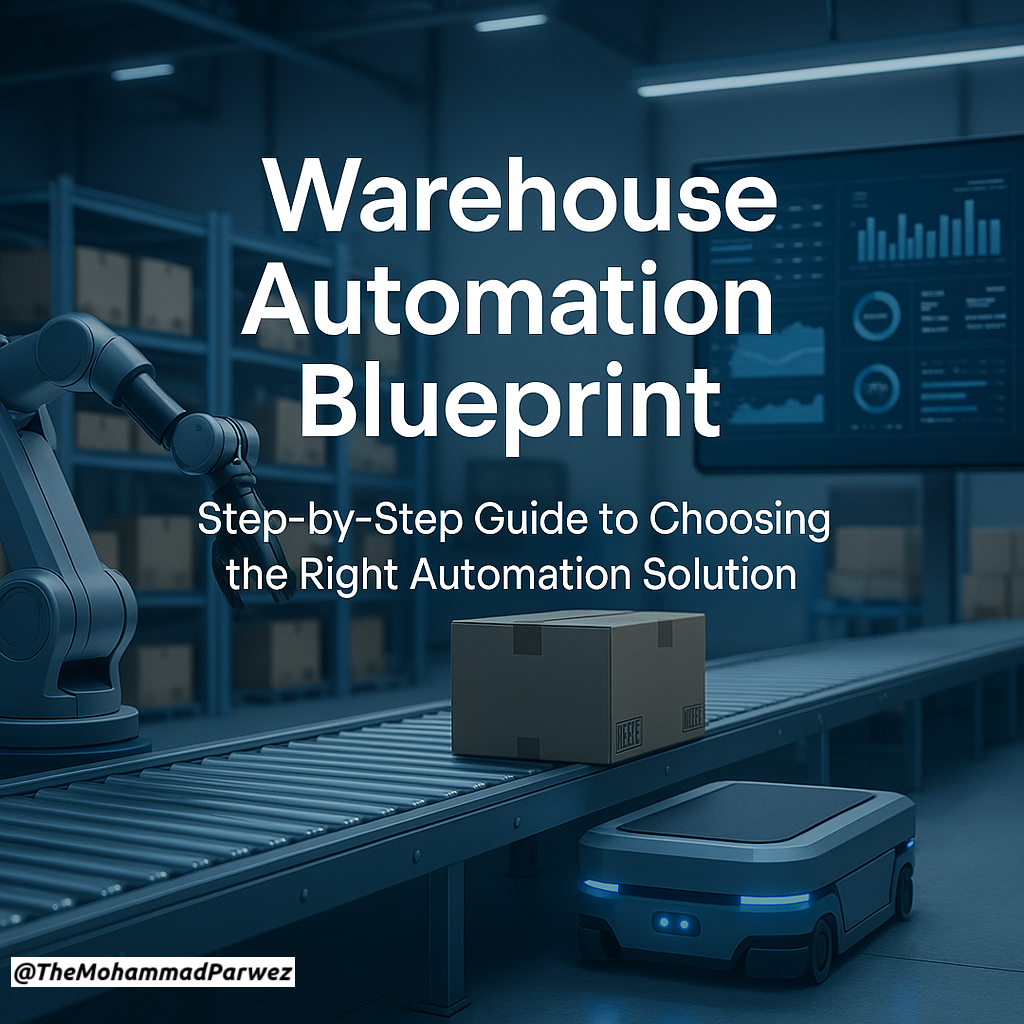🚀 Why Smart Automation Matters
In today's high-speed logistics and retail landscape, warehouse automation is no longer optional — it's strategic. But diving into automation without a clear roadmap can lead to costly missteps, mismatched technologies, and missed ROI targets.
This blueprint is your step-by-step guide to understanding your operations, defining throughput needs, and selecting the right automation technology. Whether you're scaling an eCommerce startup or modernizing a legacy warehouse, this guide will help you make confident, future-ready decisions.
1Understand Your Business Requirements
Before exploring automation tools, know your operation inside out:
- What products are stored or moved?
- SKU dimensions: size, weight, shape?
- Average vs. peak order volumes?
- Required storage capacity?
- Daily order lines and picking strategy?
- Available floor space and vertical clearance?
- Which processes should be manual, semi-automated, or fully automated?
2Define Throughput Requirements
Throughput determines how many units/orders your system must handle per hour, shift, or day.
Inbound
SKUs/pallets/cartons received per hour
Receiving windows and putaway targets
Outbound
Orders/picks per hour
Shipping cut-offs
Storage Turnover
SKU movement speed
ABC classification (fast vs. slow movers)
📌 Example: 1,200 orders/day × 3 lines/order = 3,600 picks/day → ~150 picks/hour (24h ops)
3Map the Operational Flow
Design your process flow before choosing technology:
Typical flow: Receiving → Putaway → Storage → Picking → Packing → Shipping
- Cross-docking
- Returns handling
- QC stations
- Value-added services (kitting, labeling)
4Match Requirements to the Right Technology
| Solution Type | Best Fit For | Key Considerations |
|---|---|---|
| Shuttle Systems | High-throughput, dense storage | Efficient, high CAPEX |
| AMRs | Dynamic, flexible zones | Scalable, minimal infrastructure |
| AGVs | Fixed-path transport | Requires sensors/routes |
| Conveyors | Linear, high-volume ops | Fixed layout, efficient |
| Mini-Load ASRS | Medium throughput bins | Compact, cost-effective |
| VLMs | Small/medium SKUs | Space-saving, slower |
| Pallet Shuttles | Deep-lane pallet storage | Ideal for pallet density |
5Simulate & Test Design Scenarios
Use tools like AutoCAD, FlexSim, AnyLogic, or WMS simulators to model workflows.
- Peak demand
- Shift changes
- SKU replenishment
- Picker/robot travel paths
- Downtime and recovery
6Calculate ROI & TCO
Run a full cost-benefit analysis:
CAPEX
Equipment, infrastructure, software
OPEX
Energy, maintenance, service
Labor Savings
Reduced headcount or redeployment
SLA Improvements
Accuracy, speed
Error Reduction
Inventory, picking, returns
Payback Period
Typically 2–5 years
7Learn from Real Case Studies
🔹 Zalando (Germany)
Challenge: Growing SKUs
Solution: Shuttle-based GTP
Result: 4× faster picking
🔹 Decathlon
Challenge: Seasonal SKUs
Solution: AMRs for flexible zone picking
Result: 30% faster pick rate
🔹 Unilever
Challenge: Pallet transfers
Solution: AGVs
Result: Safer ops, reduced forklifts
🔹 Amazon
Challenge: Outbound bottlenecks
Solution: Conveyor sortation
Result: 24/7 ops, high efficiency
8Plan for Scalability & Integration
Ask:
- Can the system scale?
- Is it modular or fixed?
- Does it integrate with WMS/ERP?
- What's the vendor's support model?
- Is there a manual override?
- How easy is training & change management?
🚫 Common Pitfalls to Avoid
- Automating before optimizing
- Underestimating training/change management
- Choosing trendy tech over suitable tech
- Ignoring seasonal throughput peaks
- Poor integration planning
📊 Key Metrics to Monitor Post-Implementation
Order Cycle Time
Picks/Hour per Worker/Robot
Picking Accuracy
Storage Utilization
SKU Dwell Time
Equipment Uptime (MTTR)
🔮 Future-Proofing Trends
- AI-powered slotting & forecasting
- Cobots for hybrid zones
- Digital twins for real-time ops
- Green automation (low-energy designs)
- Robotics-as-a-Service (RaaS)
💡 Expert Insight: "In 80% of automation projects I've led, hybrid models delivered the best ROI — like AMRs for flexibility + static zones for slow movers. Don't over-automate — optimize smartly."
📣 Conclusion: Choose Smart, Scale Confidently
Warehouse automation isn't just about tech — it's about aligning solutions with your business goals, operational realities, and future growth.
🌟 Key Takeaway
Start with your data. Map your flow. Choose scalable solutions. And remember: The smartest warehouses balance automation, adaptability, and people.
🙋 Need Help Choosing the Right Strategy?
We offer free consultations for warehouse leaders looking to future-proof their operations.
